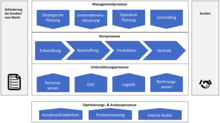Process map
The process map is the top level of the process architecture and a graphic overview that is created from modeled processes that are divided into core , management and support processes. It is to be classified in process management as part of quality management .
Benefit aspects
The benefit aspects of the process map are pyramidal and consist in the basis of the operational level, based on this on the tactical and strategic level.
Information and transparency
The process map serves as an information element and enables new employees, for example, to have a transparent insight into the process architecture of a company. Essentially, this level can also be referred to as a navigation instrument. It is the guide that paves the way for a targeted search on the process map. The hierarchical structure of the entire process architecture makes it easier to understand the process and corporate strategy.
optimization
Based on information and transparency, the task of optimization is described in the next level. The process map makes it possible to identify cross-process optimization potential. This is intended to standardize and harmonize existing processes. Similar processes are linked and incoherent ones are repositioned. This level creates a clear assignment. The process design can be found in the structure of the process map.
control
The control is located on the strategic level. The support provided by the organization chart supplements the process map with the option of determining those responsible for the respective processes. The interaction of the above Elements allows the recording of process-specific key performance indicators that function as a management tool. The process map creates a clear and comprehensive process management system with defined key figures and measured values.
Structure of a process map
A process map as a management instrument for managing and designing a company only works if the benefit aspects are already taken into account when mapping the individual processes and later when developing an entire process landscape. The further selection in core management and support processes makes the process map individual for each company. Customary industry standards are available, but a process map only develops its full potential when it is adapted to the company down to the smallest detail. Only then can it, as transparent, internal communication of the corporate strategy, help employees to identify and classify process branches and interactions along the value chain .
Individual evidence
- ↑ a b Dethloff, A .: Process Architectures: Requirements, Concepts, Case Studies . Ed .: Ulm University. Ulm 2017, p. 22–24 ( uni-ulm.de [PDF]).
- ↑ a b c d e Kühn, Harald .: Process management for experts, impulses for current and recurring topics . Imprint: Springer Gabler, Berlin, Heidelberg 2013, ISBN 978-3-642-36994-0 .

